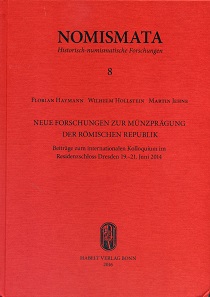by Ursula Kampmann
translated by Teresa Teklic
August 10, 2017 – You should think that after 600 years of numismatic research the informational content and insights that can be gained from purely looking at the coins would be exhausted. Nonsense! Sometimes you need to think outside the box and look at the coin from a new perspective, and suddenly you question everything you thought you knew. That happened when François de Callataÿ presented his comprehensive study on die axis in Greek numismatics in 1996. Suddenly the weird little arrows which appeared with regularity in the old, hallowed Heu-Less auction catalogues had a practical application for numismatic research. It turned out that the minting techniques of a mint – indicated by die axis – were sometimes considerably more conservative than the coins’ motifs. Thus die axis could serve as a criterion to determine the minting location.
Florian Haymann, Wilhelm Hollstein, Martin Jehne (eds.), Neue Forschungen zur Münzprägung der römischen Republik. Beiträge zum internationalen Kolloquium im Residenzschloss Dresden 19.-21. Juni 2014. (= New Research on Roman Republican Coinage. Contributions to the International Research Colloquium on Roman Republican Coinage in the Dresden Castle, June 19-21, 2014). Nomismata 8. Dr. Rudolf Habelt Verlag, Bonn 2016. 439 pp. With illustrations in black and white, 25 x 28.5 cm. Hardcover. ISBN: 978-3-7749-4048- 2. 83 euros.
In the wake of Callataÿ’s research the DFG (German Research Foundation) funded a research project between August 2012 and July 2014: “The meaning of die axis for the interpretation of Roman Republican coinage.” Responsible are Wilhelm Hollstein and Florian Haymann from the Coin Cabinet Dresden and Martin Jehne from the Technical University of Dresden. Of course the DFG didn’t provide sufficient funding. A part-time position was financed for two years. That wasn’t enough. Despite all the initiators’ efforts the analysis had to be limited to the earliest Roman Republican coinage before the introduction of the denarius and to the imperatorial coinage.
Still, the study found that while die axis can hardly contribute anything new to the interpretation of the coin motif, it can help to identify the minting location more precisely and thus help understand for which purposes and for which target audience the coins were made.
For the completion of the project they invited researchers from around the world to come to Dresden and foster an exchange on their own research on Roman Republican coinage. The invited speakers constituted something like the Who’s Who of the European coin cabinets and numismatists who are conducting research on the Roman Republic.
Of course many contributions dealt with the interpretation of die axis, but there were also a number of studies on iconography and on the history of money. Anyone who has a scholarly interest in Roman Republic coinage should take a look at this collection of articles.
And every coin dealer should carefully consider a return to regularly featuring die axis in his catalogues after consulting this book. Even though scholarly publications, too, have not done so until recently.
You can order the publication at Dr. Rudolf Habelt GmbH.
The easier option is amazon, but if we order the book directly from the publisher he can perhaps afford to update his website to modern standards.





